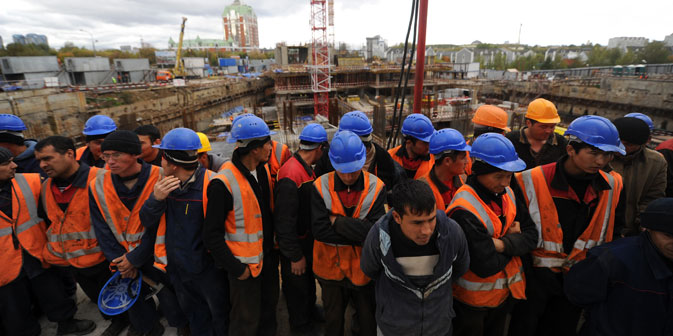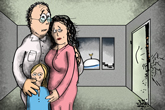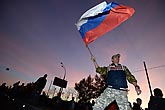Tensions over migrants test politicians

The Biryulyovo events gave a new impetus to public discussions of whether visas should be introduced for citizens of Transcaucasian and Central Asian countries. Source: Photoshot / Vostock Photo
On October 13, Russian TV channels broadcast live footage of thousands of people sweeping across Moscow’s southern residential district of Biryulyovo, wrecking a local hypermarket and breaking into a vegetable warehouse. The rioters overturned parked cars and kiosks that they suspected might be owned by immigrants.
The angry crowd were mostly nationalist youth from across Moscow. They had come to support 40 Biryulyovo residents who had assembled outside the local police station earlier that day, demanding police find the killer of Yegor Shcherbakov. Shcherbakov, 25, an ethnic Russian, was stabbed on the night of October 10, in the presence of his fiancée, while attempting to defend a female passer-by from the sexual advances of a stranger.
Warehouse ‘a nest of crime’
The murder came after years of pent-up discontent among Biryulyovo dwellers with what they saw as indifference and inaction on the part of the local police and district administration. This was not the first time local residents had taken to the streets demanding stricter immigration controls and the closure of the nearby vegetable warehouse, which employs thousands of immigrants from the Caucasus and is widely viewed by local people as a nest of crime. The face of Shcherbakov’s suspected murderer, which was captured on CCTV cameras, strongly resembled those of a native of the Caucasus.
About 400 arrests were made after the riot. However, within two days, the protesters’ demands were met in full. The best detectives were involved in investigating Shcherbakov’s murder and the suspected perpetrator was tracked down and delivered personally to the Russian interior minister. The warehouse, the largest such facility in Europe, was closed, officially for breaches of sanitation regulations.
New call for visas
The Biryulyovo events gave a new impetus to public discussions of whether visas should be introduced for citizens of Transcaucasian and Central Asian countries. According to a survey conducted by the Levada Centre, a sociological research organisation, in June this year, 84 percent of Russians support the idea. However, President Vladimir Putin has spoken against such a move, saying that it would prompt members of the Commonwealth of Independent States (CIS) countries to turn away from Russia.
Just as in Britain, where there has been a debate for years about the impact of immigration on jobs and public services, unchecked immigration is beginning to worry ordinary Russians. Although polls suggest that the problem ranks only eighth on the list of the population’s greatest concerns, the proportion of those viewing immigrants as the cause of the country’s greatest problems has increased from 7 percent to 27 percent over the past eight years.
In Moscow, immigration is already seen as the greatest problem, not least because cracking down on illegal immigrants was among the key points in the electoral manifestos of all the candidates during this summer’s mayoral election campaign.
Xenophobia on the rise
The rise in the level of household xenophobia in Russia first became noticeable in the second half of the Nineties, sociologists note. Lev Gudkov, director of the Levada Centre, says: “After the beginning of the [economic] reforms, following the frustration caused by the destruction of the [Soviet] social system, came the time of negative self-assertion and searches for a national identity.
“Since there was not much left to be proud of [in post-Soviet Russia], this self-assertion mostly took the form of people projecting their personal complexes and antipathies on to all ‘aliens’. The process became aggravated during the 2000s, when the government set a course towards reviving national traditions, conservatism, and stability.”
Demographic analysts point out that Russia would benefit from inviting more immigrants, who would make up for the continuing decline in the country’s own population. “We have observed a negative demographic trend since 1992,” says Anatoly Vishnevsky, director of Moscow’s Institute of Demography at the National Research University – Higher School of Economics. “Natural attrition over the past 20 years amounted to 13.4 million people. In other words, the population of Russia should have decreased by 13.4 million by now, but in reality it has only declined by 5.3 million people. This difference is down to immigration.”
Dr Gudkov believes that inter-ethnic tensions result from an illegal inflow of cheap labour from abroad. One factor behind the thriving black market in labour in Russia is that quotas for hiring immigrant workers are significantly lower than the market demands. This year, the quota stands at 1.7 million people, whereas Dr Gudkov estimates that Russia’s economy needs 4.5 to five million a year.
Criminals dodging prosecution
Russia’s Minister for the Interior Vladimir Kolokoltsev said in September that he believed criminals were using visa-free travel between different CIS countries to avoid prosecution.
According to the Russian Investigative Committee, nearly one in six murders and one in three rapes recorded in Moscow in the first nine months of 2013 were committed by foreigners. This is despite Mayor Sergey Sobyanin’s statement that immigrants account for only around 5 percent of the population in Russia’s capital. All this adds fuel to anti-immigrant sentiment, particularly in socially disadvantaged neighbourhoods like Biryulyovo. The district, on the southern outskirts of Moscow, is isolated from the rest of the city because there is no Metro underground line. The result is the lowest housing prices in Moscow, which makes Biryulyovo especially popular with immigrants working at the local vegetable warehouse, the district’s main employer.
“Biryulyovo is where people with low incomes choose to live; xenophobia is higher there because of the people’s overall proneness to conflicts and readiness to vent their aggression at foreigners,” Dr. Gudkov says. “Such a social environment is common to other neighbourhoods, so the Biryulyovo protests and riots will most likely be replicated [elsewhere in Moscow] in the next several months.
He added: “These will not be mass riots but rather pockets of violence in those areas where a critical level of tension has been reached and is likely to be be set off at the slightest touch, most possibly by a criminal incident.”
Integration on the agenda
The disturbances in Moscow were nowhere near the scale witnessed in London and other English cities in 2011, which began after police shot dead a man in Tottenham. But the localised riots have prompted the Russian government to review its immigration policy. Parliament is discussing amendments to tighten immigration laws and compel foreigners to integrate into Russian society.
Various measures are being discussed, from fingerprinting foreign workers to setting up a special force to fight ethnic crime. A bill has also been submitted to parliament that would make it compulsory for immigrants to learn Russian.
In the meantime, the flow of people to Russia shows no signs of abating. According to a United Nations report released in September, Russia ranks second in the world after the United States for the number of immigrants, with 11 million foreigners compared to 143.5 million Russian nationals.
All rights reserved by Rossiyskaya Gazeta.
Subscribe
to our newsletter!
Get the week's best stories straight to your inbox



